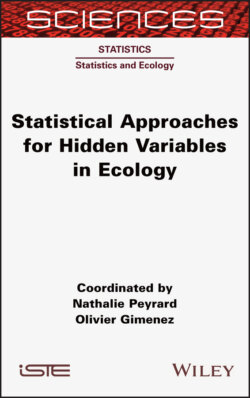Читать книгу Statistical Approaches for Hidden Variables in Ecology - Nathalie Peyrard - Страница 43
1.4. References
ОглавлениеAkaike, H. (1973). Information theory as an extension of the maximum likelihood principle. In Second International Symposium on Information Theory, Petrov, B.N., Csaki, F. (eds). Akademiai Kiado, Budapest.
Bacci, S., Pandolfi, S., Pennoni, F. (2014). A comparison of some criteria for states selection in the latent Markov model for longitudinal data. Advances in Data Analysis and Classification, 8(2), 125–145.
Biernacki, C., Celeux, G., Govaert, G. (2000). Assessing a mixture model for clustering with the integrated completed likelihood. IEEE Transactions on Pattern Analysis and Machine Intelligence, 22(7), 719–725.
Calenge, C., Dray, S., Royer-Carenzi, M. (2009). The concept of animals’ trajectories from a data analysis perspective. Ecological Informatics, 4(1), 34–41.
Carpenter, B., Gelman, A., Hoffman, M.D., Lee, D., Goodrich, B., Betancourt, M., Brubaker, M., Guo, J., Li, P., Riddell, A. (2017). Stan: A probabilistic programming language. Journal of Statistical Software, 76(1), 1–32.
Dempster, A., Laird, N., Rubin, D. (1977). Maximum likelihood from incomplete data via the EM algorithm. Journal of the Royal Statistical Society, 39(1), 1–38.
Elwen, S., Meÿer, M.A., Best, P.B., Kotze, P., Thornton, M., Swanson, S. (2006). Range and movements of female Heaviside’s dolphins (Cephalorhynchus heavisidii), as determined by satellite-linked telemetry. Journal of Mammalogy, 87(5), 866–877.
Freitas, C., Lydersen, C., Fedak, M.A., Kovacs, K.M. (2008). A simple new algorithm to filter marine mammal Argos locations. Marine Mammal Science, 24(2), 315–325.
Gloaguen, P., Mahévas, S., Rivot, E., Woillez, M., Guitton, J., Vermard, Y., Etienne, M.-P. (2015). An autoregressive model to describe fishing vessel movement and activity. Environmetrics, 26(1), 17–28.
Guédon, Y. (2007). Exploring the state sequence space for hidden Markov and semi-Markov chains. Computational Statistics & Data Analysis, 51(5), 2379–2409.
Gurarie, E., Andrews, R.D., Laidre, K.L. (2009). A novel method for identifying behavioural changes in animal movement data. Ecology Letters, 12(5), 395–408.
Jammalamadaka, S.R. and Sengupta, A. (2001). Topics in Circular Statistics, Volume 5. World Scientific, Singapore.
Johnson, D.S., London, J.M., Lea, M.-A., Durban, J.W. (2008). Continuous-time correlated random walk model for animal telemetry data. Ecology, 89(5), 1208–1215.
Lopez, R., Malardé, J.-P., Danès, P., Gaspar, P. (2015). Improving Argos Doppler location using multiple-model smoothing. Animal Biotelemetry, 3(1), 32.
Lunn, D.J., Thomas, A., Best, N., Spiegelhalter, D. (2000). Winbugs – A Bayesian modelling framework: Concepts, structure, and extensibility. Statistics and Computing, 10(4), 325–337.
Michelot, T., Langrock, R., Patterson, T.A. (2016). moveHMM: An R package for the statistical modelling of animal movement data using hidden Markov models. Methods in Ecology and Evolution, 7(11), 1308–1315 [Online]. Available at: https://besjournals.onlinelibrary.wiley.com/doi/abs/10.1111/2041-210X.12578.
Morales, J.M., Haydon, D.T., Frair, J., Holsinger, K.E., Fryxell, J.M. (2004). Extracting more out of relocation data: Building movement models as mixtures of random walks. Ecology, 85(9), 2436–2445.
Nathan, R., Getz, W.M., Revilla, E., Holyoak, M., Kadmon, R., Saltz, D., Smouse, P.E. (2008). A movement ecology paradigm for unifying organismal movement research. Proceedings of the National Academy of Sciences, 105(49), 19052–19059.
Patterson, T.A., Thomas, L., Wilcox, C., Ovaskainen, O., Matthiopoulos, J. (2008). State–space models of individual animal movement. Trends in Ecology & Evolution, 23(2), 87–94 [Online]. Available at: http://www.sciencedirect.com/science/article/pii/S0169534707003588.
Patterson, T.A., McConnell, B.J., Fedak, M.A., Bravington, M.V., Hindell, M.A. (2010). Using GPS data to evaluate the accuracy of state–space methods for correction of Argos satellite telemetry error. Ecology, 91(1), 273–285.
Rabiner, L.R. (1989). A tutorial on hidden Markov models and selected applications in speech recognition. Proceedings of the IEEE, 77(2), 257–286.
Tusell, F. (2011). Kalman filtering in R. Journal of Statistical Software, 39(2), 1–27.
de Valpine, P., Turek, D., Paciorek, C., Anderson-Bergman, C., Temple Lang, D., Bodik, R. (2017). Programming with models: Writing statistical algorithms for general model structures with NIMBLE. Journal of Computational and Graphical Statistics, 26, 403–413.
1 1 This hypothesis is helpful from a mathematical perspective, and results in efficient hidden state reconstruction algorithms. From a modeling perspective, its use is debatable, since it implies that the individual has no memory of its past trajectory.
2 2 One degree of longitude at the equator does not correspond to the same distance as 1 degree of longitude at the 45th parallel, for example.
3 3 The “bivariate velocity” model can still be interpreted a posteriori using the classic step length/angle approach, as shown here. In our example, as the majority of turning angles are close to 0, the Vp component of the metric is closely correlated with the step length.
